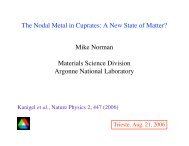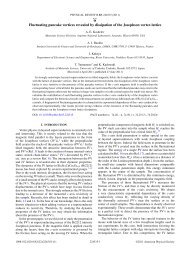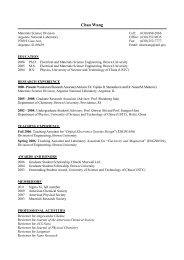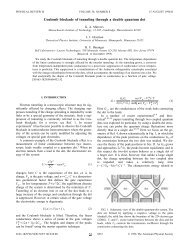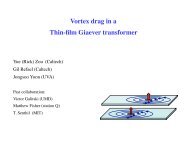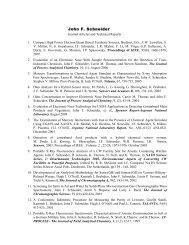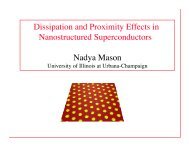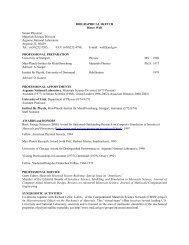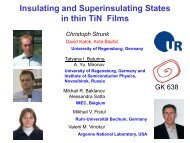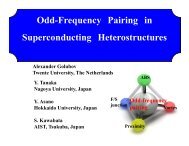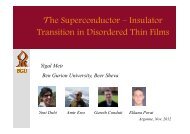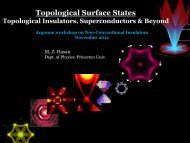Theory of Relaxor Ferroelectrics - Argonne National Laboratory
Theory of Relaxor Ferroelectrics - Argonne National Laboratory
Theory of Relaxor Ferroelectrics - Argonne National Laboratory
Create successful ePaper yourself
Turn your PDF publications into a flip-book with our unique Google optimized e-Paper software.
<strong>Ferroelectrics</strong> vs <strong>Relaxor</strong> <strong>Ferroelectrics</strong> <strong>Theory</strong> <strong>of</strong> <strong>Relaxor</strong> <strong>Ferroelectrics</strong> Results Conclusions<br />
<strong>Theory</strong> <strong>of</strong> <strong>Relaxor</strong> <strong>Ferroelectrics</strong><br />
Gian G. Guzmán-Verri 1,2 & Chandra M. Varma 2<br />
1 Materials Science Division, <strong>Argonne</strong> <strong>National</strong> <strong>Laboratory</strong><br />
2 Department <strong>of</strong> Physics and Astronomy, UC Riverside<br />
MTI Non-conventional Insulators Workshop<br />
11/14/2012<br />
Work partially funded by the UC Lab Fees Research Program<br />
09-LR-01-118286-HELF
<strong>Ferroelectrics</strong> vs <strong>Relaxor</strong> <strong>Ferroelectrics</strong> <strong>Theory</strong> <strong>of</strong> <strong>Relaxor</strong> <strong>Ferroelectrics</strong> Results Conclusions<br />
Why are relaxors interesting? New physics & technologically important<br />
E ⩵0<br />
1 Ε, relaxors<br />
Ε<br />
E E c<br />
T fe T max T CW T B<br />
Broad region <strong>of</strong> fluctuations (diffuse phase transition).<br />
Several special temperatures.<br />
Neutron diffuse scattering exhibits unusual line shapes.<br />
Widely used for capacitors.
<strong>Ferroelectrics</strong> vs <strong>Relaxor</strong> <strong>Ferroelectrics</strong> <strong>Theory</strong> <strong>of</strong> <strong>Relaxor</strong> <strong>Ferroelectrics</strong> Results Conclusions<br />
Outline<br />
1 <strong>Ferroelectrics</strong> vs <strong>Relaxor</strong> <strong>Ferroelectrics</strong><br />
Unit Cell<br />
Dielectric Constant<br />
S<strong>of</strong>t Modes<br />
Diffuse Scattering<br />
2 <strong>Theory</strong> <strong>of</strong> <strong>Relaxor</strong> <strong>Ferroelectrics</strong><br />
Model Hamiltonian<br />
Lorentz and Onsager Approximations<br />
3 Results<br />
S<strong>of</strong>t Mode<br />
Diffuse Scattering<br />
Dielectric Constant<br />
4 Conclusions
<strong>Ferroelectrics</strong> vs <strong>Relaxor</strong> <strong>Ferroelectrics</strong> <strong>Theory</strong> <strong>of</strong> <strong>Relaxor</strong> <strong>Ferroelectrics</strong> Results Conclusions<br />
Outline<br />
1 <strong>Ferroelectrics</strong> vs <strong>Relaxor</strong> <strong>Ferroelectrics</strong><br />
Unit Cell<br />
Dielectric Constant<br />
S<strong>of</strong>t Modes<br />
Diffuse Scattering<br />
2 <strong>Theory</strong> <strong>of</strong> <strong>Relaxor</strong> <strong>Ferroelectrics</strong><br />
Model Hamiltonian<br />
Lorentz and Onsager Approximations<br />
3 Results<br />
S<strong>of</strong>t Mode<br />
Diffuse Scattering<br />
Dielectric Constant<br />
4 Conclusions
<strong>Ferroelectrics</strong> vs <strong>Relaxor</strong> <strong>Ferroelectrics</strong> <strong>Theory</strong> <strong>of</strong> <strong>Relaxor</strong> <strong>Ferroelectrics</strong> Results Conclusions<br />
Unit Cell<br />
Unit Cell<br />
Complex perovskite: ABO 3 , B-site disordered.<br />
e.g.: PbMg 1/3 Nb 2/3 O 3 . (PMN).<br />
Mg +2 and Nb +5 are non-isovalent.<br />
Ionic radii: 0.72Å (Mg +2 ) and 0.64Å (Nb +5 ).<br />
<strong>Ferroelectrics</strong>: B-site ordered.<br />
e.g.: PbTiO 3 (PTO), BaTiO 3 (BTO).<br />
Compositional disorder is essential.<br />
Pb 4<br />
Mg 2 Nb 5<br />
O 2
<strong>Ferroelectrics</strong> vs <strong>Relaxor</strong> <strong>Ferroelectrics</strong> <strong>Theory</strong> <strong>of</strong> <strong>Relaxor</strong> <strong>Ferroelectrics</strong> Results Conclusions<br />
Dielectric Constant<br />
Dielectric Constant<br />
J. Remeika et al., Mater. Res. Bull. 5, 37 (1970); V. Bovtun et al., <strong>Ferroelectrics</strong> 298, 23 (2004)<br />
Ε10 3<br />
8.0<br />
6.0<br />
4.0<br />
2.0<br />
PbTiO 3<br />
T 715 K<br />
5.0 10 5 K<br />
0.8<br />
0.6<br />
0.4<br />
0.2<br />
Ε 1 10 3<br />
Ε10 3<br />
15.0<br />
10.0<br />
5.0<br />
PMN<br />
10 2 Hz<br />
10 3 Hz<br />
10 5 Hz<br />
10 9 Hz<br />
T 410 K<br />
1.2 10 5 K<br />
2.5<br />
2.0<br />
1.5<br />
1.0<br />
0.5<br />
Ε 1 10 3<br />
500 550 600 650 700 750 800 850<br />
T K<br />
200 300 400 500 600 700<br />
T K<br />
sharp peak<br />
follows Curie-Weiss law<br />
little frequency dispersion (< 10 12 Hz)<br />
broad peak<br />
deviates Curie-Weiss law (T < T B )<br />
strong frequency dispersion
<strong>Ferroelectrics</strong> vs <strong>Relaxor</strong> <strong>Ferroelectrics</strong> <strong>Theory</strong> <strong>of</strong> <strong>Relaxor</strong> <strong>Ferroelectrics</strong> Results Conclusions<br />
S<strong>of</strong>t Modes<br />
S<strong>of</strong>t Modes (<strong>Ferroelectrics</strong>)<br />
P. W. Anderson, Fizika Dielektrikov, Akad. Nauk. (1960); W. Cochran, Phys. Rev. Lett. 3 412, (1959);<br />
G. Shirane et al., Phys. Rev. B. 2, 155 (1970)<br />
60<br />
ħTO 2 meV 2 <br />
50<br />
40<br />
30<br />
20<br />
10<br />
PTO, q ⩵0<br />
T c<br />
<br />
<br />
<br />
<br />
700 800 900 1000 1100<br />
Inversion symmetry must be broken.<br />
Lattice instability (TO mode s<strong>of</strong>tens).<br />
T K<br />
Lyddane-Sachs-Teller: ɛ(0)<br />
ɛ(∞) = ( ΩLO<br />
Ω TO<br />
) 2<br />
∝ 1<br />
T T c<br />
Pb 4<br />
Ti 2<br />
O 2<br />
T −Tc .<br />
T T c
<strong>Ferroelectrics</strong> vs <strong>Relaxor</strong> <strong>Ferroelectrics</strong> <strong>Theory</strong> <strong>of</strong> <strong>Relaxor</strong> <strong>Ferroelectrics</strong> Results Conclusions<br />
S<strong>of</strong>t Modes<br />
S<strong>of</strong>t Modes (<strong>Relaxor</strong>s)<br />
C. Stock et al., J. Phys. Soc. Jpn. 74, 3002 (2005).<br />
ħTO 2 meV 2 <br />
120<br />
100<br />
80<br />
60<br />
40<br />
20<br />
<br />
<br />
<br />
<br />
<br />
<br />
<br />
T CW<br />
<br />
<br />
PMN,q ⩵0<br />
T B<br />
<br />
<br />
<br />
0<br />
0 200 400 600 800 1000<br />
T K<br />
Inversion symmetry is not broken macroscopically.<br />
Minimum at T CW .<br />
Overdamped for 200 K T 620 K.
<strong>Ferroelectrics</strong> vs <strong>Relaxor</strong> <strong>Ferroelectrics</strong> <strong>Theory</strong> <strong>of</strong> <strong>Relaxor</strong> <strong>Ferroelectrics</strong> Results Conclusions<br />
Diffuse Scattering<br />
Diffuse Scattering: <strong>Ferroelectrics</strong> vs <strong>Relaxor</strong>s<br />
Y. Yamada et al., Phys. Rev. Lett. 177, 848 (1969); S. N. Gvasaliya et al., J. Phys.: Condens. Matter 17, 4343 (2005)<br />
Internsitya.u.<br />
Internsitya.u.<br />
Internsitya.u.<br />
BTO,T 393K<br />
10 6 PMN,T ⩵ 450 K<br />
<br />
<br />
10 5 Bragg Peak<br />
10 5<br />
<br />
Diffuse Scatt.<br />
<br />
10 4<br />
<br />
10 3<br />
10 3<br />
<br />
<br />
10 2<br />
<br />
<br />
<br />
<br />
10 1<br />
10 1<br />
100.50.40.30.20.10.00.10.20.30.40.5<br />
7 0.50.40.30.20.10.00.10.20.30.40.5<br />
<br />
BTO,T0,1q,0 ≃393K r.l.u. 10 6 PMN,T ⩵1,1,q 300 K r.l.u.<br />
10 7 10 7 10 5<br />
10 5<br />
<br />
10 3<br />
<br />
10 4<br />
10 3<br />
<br />
10 2<br />
<br />
<br />
<br />
10 1<br />
10 1<br />
100.50.40.30.20.10.00.10.20.30.40.5<br />
7 0.50.40.30.20.10.00.10.20.30.40.5<br />
<br />
BTO,T0,1q,0 ≲393K r.l.u. 10 6 PMN,T ⩵1,1,q 150 K<br />
r.l.u.<br />
<br />
10 5<br />
10 5<br />
10 4<br />
10 3<br />
10 3<br />
<br />
<br />
10 2<br />
<br />
10 1<br />
0.5 0.25 0.0 0.25<br />
10 1<br />
0.5 0.5 0.25 0.0 0.25 0.5<br />
0,1q,0 r.l.u.<br />
1,1,q r.l.u.<br />
Internsitya.u.<br />
Internsitya.u.<br />
Internsitya.u.<br />
Elastic diffuse scattering in PMN does not behave as a simple Lorentzian.
<strong>Ferroelectrics</strong> vs <strong>Relaxor</strong> <strong>Ferroelectrics</strong> <strong>Theory</strong> <strong>of</strong> <strong>Relaxor</strong> <strong>Ferroelectrics</strong> Results Conclusions<br />
Diffuse Scattering<br />
Diffuse Scattering: <strong>Ferroelectrics</strong> vs <strong>Relaxor</strong>s<br />
Y. Yamada et al., Phys. Rev. Lett. 177, 848 (1969); S. N. Gvasaliya et al., J. Phys.: Condens. Matter 17, 4343 (2005)<br />
Intensity a.u.<br />
T c<br />
BTO<br />
Yamada et al . 101<br />
397 420 450 480<br />
T K<br />
Intensity a.u.<br />
12.0<br />
9.0<br />
6.0<br />
3.0<br />
<br />
<br />
<br />
<br />
<br />
<br />
<br />
<br />
<br />
<br />
<br />
<br />
<br />
<br />
<br />
<br />
<br />
<br />
<br />
<br />
0.0<br />
0 100 200 300 400 500 600 700<br />
<br />
<br />
<br />
<br />
<br />
<br />
<br />
<br />
<br />
T K<br />
PMN<br />
Hiraka110 ,100<br />
Gvasaliya110<br />
<br />
<br />
FE fluctuations extend over narrow temperature range.<br />
RFE fluctuations extend over broad temperature range and<br />
saturate.
<strong>Ferroelectrics</strong> vs <strong>Relaxor</strong> <strong>Ferroelectrics</strong> <strong>Theory</strong> <strong>of</strong> <strong>Relaxor</strong> <strong>Ferroelectrics</strong> Results Conclusions<br />
Outline<br />
1 <strong>Ferroelectrics</strong> vs <strong>Relaxor</strong> <strong>Ferroelectrics</strong><br />
Unit Cell<br />
Dielectric Constant<br />
S<strong>of</strong>t Modes<br />
Diffuse Scattering<br />
2 <strong>Theory</strong> <strong>of</strong> <strong>Relaxor</strong> <strong>Ferroelectrics</strong><br />
Model Hamiltonian<br />
Lorentz and Onsager Approximations<br />
3 Results<br />
S<strong>of</strong>t Mode<br />
Diffuse Scattering<br />
Dielectric Constant<br />
4 Conclusions
<strong>Ferroelectrics</strong> vs <strong>Relaxor</strong> <strong>Ferroelectrics</strong> <strong>Theory</strong> <strong>of</strong> <strong>Relaxor</strong> <strong>Ferroelectrics</strong> Results Conclusions<br />
Model Hamiltonian<br />
Model Hamiltonian<br />
Anharmonic potential (V (|u i |))+ dipole forces (v ij ) + local quenched random fields (h i )<br />
H = ∑ i<br />
( |Πi | 2<br />
2M<br />
)<br />
+ V (|u i|) − ∑ u i · v ij · u j − ∑<br />
i
<strong>Ferroelectrics</strong> vs <strong>Relaxor</strong> <strong>Ferroelectrics</strong> <strong>Theory</strong> <strong>of</strong> <strong>Relaxor</strong> <strong>Ferroelectrics</strong> Results Conclusions<br />
Lorentz and Onsager Approximations<br />
Lorentz and Onsager Fields<br />
Onsager, J. Am. Chem. Soc. 58,1486 (1936); Van Vleck, J. Chem. Phys. 5 320 (1937); Brout and Thomas., Phys. 3, 317 (1967)<br />
Lorentz Field (LF):<br />
E local<br />
i<br />
≃ E Lorentz<br />
i<br />
= ∑ j<br />
Clausius-Mossotti (CM):<br />
ɛ − 1<br />
ɛ + 2 = 4π 3<br />
Water is FE at ∼ 100 ◦ C!<br />
np 2<br />
3k B T<br />
v ij 〈u j 〉 th<br />
Onsager Field (OF):<br />
E local<br />
i<br />
≃ E Onsager<br />
i<br />
= E cavity<br />
i<br />
Onsager formula (Of):<br />
ɛ − 1 =<br />
No FE at finite T .<br />
ɛ 4πnp 2<br />
2ɛ + 1 k B T<br />
+ E reaction<br />
i<br />
Onsager: LF overestimates the local field.<br />
Van Vleck: from high T expansion, CM (1/T 2 ), Of (1/T 4 ).<br />
Brout and Thomas: OF guarantees fluctuation-dissipation theorem.
<strong>Ferroelectrics</strong> vs <strong>Relaxor</strong> <strong>Ferroelectrics</strong> <strong>Theory</strong> <strong>of</strong> <strong>Relaxor</strong> <strong>Ferroelectrics</strong> Results Conclusions<br />
Lorentz and Onsager Approximations<br />
Model Hamiltonian (without compositional disorder)<br />
M 0<br />
⊥ <br />
2 v0<br />
⊥<br />
0.3<br />
0.2<br />
0.1<br />
Onsager<br />
Lorentz<br />
t Ons<br />
∝<br />
Ln1 t Ons <br />
0.0<br />
0.0 0.5 1.0 1.5 2.0<br />
T T c<br />
Lorentz<br />
∝t L<br />
3Γ kBTc v 0<br />
⊥2<br />
0.30<br />
0.25<br />
0.20<br />
0.15<br />
0.10<br />
0.05<br />
Lorentz<br />
Onsager<br />
0.00<br />
0.0 0.2 0.4 0.6 0.8 1.0<br />
v 0 ⊥ Κ<br />
v 0<br />
⊥<br />
Dipole forces + OF → logarithmic corrections.<br />
Fluctuations suppress T c .
<strong>Ferroelectrics</strong> vs <strong>Relaxor</strong> <strong>Ferroelectrics</strong> <strong>Theory</strong> <strong>of</strong> <strong>Relaxor</strong> <strong>Ferroelectrics</strong> Results Conclusions<br />
Lorentz and Onsager Approximations<br />
Model Hamiltonian (with compositional disorder)<br />
Compositional disorder, Vilfan and Cowley (1985).<br />
〈u i 〉 th = ∑ 〈 〉<br />
χij<br />
c h j<br />
j<br />
Self-consistent equations<br />
〈 〈<br />
u 2 i<br />
〉 0<br />
th〉<br />
c<br />
) 2<br />
+<br />
(v ⊥ 0 − vq )<br />
,<br />
MΩ 2 q<br />
(Ω = M ⊥ 0<br />
( ) (〈 2 〈 〉 0<br />
M Ω ⊥ 0 = κ + 3γ ui<br />
th〉<br />
2 c<br />
〈<br />
− 〈u i 〉 0 2 〉<br />
th = 1 ∑<br />
c N<br />
q<br />
<br />
2MΩ q<br />
coth<br />
〈<br />
〈u i 〉 0 2 〉<br />
th = 1 ∑ ∆ 2<br />
( )<br />
c N<br />
q MΩ 2 2<br />
.<br />
q<br />
〈<br />
+ 〈u i 〉 0 2 〉<br />
th<br />
c<br />
( βΩq<br />
2<br />
)<br />
,<br />
)<br />
− v ⊥ 0 ,
<strong>Ferroelectrics</strong> vs <strong>Relaxor</strong> <strong>Ferroelectrics</strong> <strong>Theory</strong> <strong>of</strong> <strong>Relaxor</strong> <strong>Ferroelectrics</strong> Results Conclusions<br />
Outline<br />
1 <strong>Ferroelectrics</strong> vs <strong>Relaxor</strong> <strong>Ferroelectrics</strong><br />
Unit Cell<br />
Dielectric Constant<br />
S<strong>of</strong>t Modes<br />
Diffuse Scattering<br />
2 <strong>Theory</strong> <strong>of</strong> <strong>Relaxor</strong> <strong>Ferroelectrics</strong><br />
Model Hamiltonian<br />
Lorentz and Onsager Approximations<br />
3 Results<br />
S<strong>of</strong>t Mode<br />
Diffuse Scattering<br />
Dielectric Constant<br />
4 Conclusions
<strong>Ferroelectrics</strong> vs <strong>Relaxor</strong> <strong>Ferroelectrics</strong> <strong>Theory</strong> <strong>of</strong> <strong>Relaxor</strong> <strong>Ferroelectrics</strong> Results Conclusions<br />
Diffuse Scattering (PMN)<br />
a 2 10 3<br />
3.0<br />
2.0<br />
<br />
<br />
<br />
<br />
<br />
<br />
<br />
<br />
<br />
<br />
<br />
<br />
<br />
<br />
<br />
<br />
<br />
<br />
<br />
<br />
<br />
<br />
<br />
Hiraka 110 ,100<br />
Gvasaliya 110<br />
Present Model<br />
S 0.05<br />
⊥<br />
1.0<br />
<br />
<br />
0.0<br />
0.0 100 200 300 400 500 600 700<br />
<br />
<br />
<br />
<br />
<br />
<br />
T K<br />
<br />
<br />
<br />
<br />
S q =<br />
<br />
2MΩ q<br />
coth<br />
( βΩq<br />
2<br />
)<br />
+ ( ∆2<br />
( ) 2 )<br />
)<br />
MΩ 2 2<br />
, MΩ 2 q = M Ω ⊥ 0 +<br />
(v 0 ⊥ − vq<br />
q
<strong>Ferroelectrics</strong> vs <strong>Relaxor</strong> <strong>Ferroelectrics</strong> <strong>Theory</strong> <strong>of</strong> <strong>Relaxor</strong> <strong>Ferroelectrics</strong> Results Conclusions<br />
Diffuse Scattering (PMN)<br />
S q<br />
⊥ a<br />
2<br />
<br />
10 6 <br />
a 150K<br />
10 5<br />
<br />
<br />
10 4<br />
<br />
<br />
10 3<br />
<br />
<br />
10 2<br />
<br />
<br />
<br />
<br />
<br />
<br />
10 1<br />
q rlu<br />
S q<br />
⊥ a<br />
2<br />
10 6 <br />
b 300 K<br />
10 5<br />
<br />
10 4<br />
<br />
<br />
<br />
10 3<br />
<br />
10 2<br />
<br />
<br />
<br />
q rlu<br />
<br />
<br />
<br />
<br />
<br />
10 1<br />
0.3 0.2 0.1 0.0 0.1 0.2 0.3 0.3 0.2 0.1 0.0 0.1 0.2 0.3<br />
<br />
<br />
<br />
<br />
<br />
<br />
S q =<br />
<br />
2MΩ q<br />
coth<br />
( βΩq<br />
2<br />
)<br />
+ ( ∆2<br />
) 2 )<br />
)<br />
MΩ 2 2<br />
, MΩ 2 q<br />
(Ω = M ⊥ 0 +<br />
(v 0 ⊥ − vq<br />
q
<strong>Ferroelectrics</strong> vs <strong>Relaxor</strong> <strong>Ferroelectrics</strong> <strong>Theory</strong> <strong>of</strong> <strong>Relaxor</strong> <strong>Ferroelectrics</strong> Results Conclusions<br />
<br />
<br />
Dielectric Constant (PMN)<br />
4 Π<br />
10 3<br />
Ε 1<br />
4 Π<br />
3<br />
6.0<br />
5.0<br />
4.0<br />
3.0<br />
2.0<br />
1.0<br />
<br />
<br />
<br />
a PMN<br />
<br />
<br />
<br />
<br />
<br />
<br />
10 2 Hz<br />
<br />
<br />
<br />
<br />
<br />
<br />
10 3 Hz<br />
<br />
<br />
<br />
<br />
<br />
<br />
<br />
<br />
10 9 Hz<br />
<br />
<br />
<br />
<br />
Present Model w<br />
<br />
<br />
<br />
ConstantDamping<br />
<br />
<br />
<br />
<br />
<br />
<br />
<br />
<br />
<br />
<br />
<br />
<br />
<br />
<br />
<br />
<br />
<br />
<br />
<br />
<br />
<br />
<br />
<br />
<br />
<br />
<br />
0.0<br />
100 200 300 400 500 600 700<br />
T K<br />
4 Π<br />
10 3<br />
Ε 1<br />
4 Π<br />
3<br />
6.0<br />
5.0<br />
4.0<br />
3.0<br />
2.0<br />
1.0<br />
<br />
<br />
<br />
b PMN<br />
<br />
<br />
<br />
<br />
<br />
<br />
10 2 Hz<br />
<br />
<br />
<br />
<br />
<br />
<br />
10 3 Hz<br />
<br />
<br />
<br />
<br />
<br />
<br />
<br />
<br />
10 9 Hz<br />
<br />
<br />
<br />
<br />
Present Model w<br />
<br />
<br />
<br />
Variable Damping<br />
<br />
<br />
<br />
<br />
<br />
<br />
<br />
<br />
<br />
<br />
<br />
<br />
<br />
<br />
<br />
<br />
<br />
<br />
<br />
<br />
<br />
<br />
<br />
<br />
<br />
<br />
<br />
0.0<br />
100 200 300 400 500 600 700<br />
T K<br />
χ −1<br />
0 (ω) = M(Ω⊥ 0 )2 + iωΓ[ω], Γ[ω]: damping function.<br />
(<br />
ɛ(ω) = 1 + 4π nz ∗2) χ 0 (ω).<br />
Discrepancy will be discussed at the end.
<strong>Ferroelectrics</strong> vs <strong>Relaxor</strong> <strong>Ferroelectrics</strong> <strong>Theory</strong> <strong>of</strong> <strong>Relaxor</strong> <strong>Ferroelectrics</strong> Results Conclusions<br />
S<strong>of</strong>t Mode<br />
Results: s<strong>of</strong>t mode<br />
M 0<br />
⊥ <br />
2 v0<br />
⊥ 10<br />
1<br />
3.0<br />
2.0<br />
1.0<br />
2 v 0 ⊥ a 2 ⩵1.00<br />
2 v 0 ⊥ a 2 ⩵0.50<br />
2 v 0 ⊥ a 2 ⩵0.25<br />
2 v 0 ⊥ a 2 ⩵0.00<br />
0.0 0.5 1.0 1.5 2.0<br />
T T c<br />
Dipole forces and random fields suppress long-range order<br />
for arbitrarily small disorder.
<strong>Ferroelectrics</strong> vs <strong>Relaxor</strong> <strong>Ferroelectrics</strong> <strong>Theory</strong> <strong>of</strong> <strong>Relaxor</strong> <strong>Ferroelectrics</strong> Results Conclusions<br />
Diffuse Scattering<br />
Results: elastic diffuse scattering<br />
400<br />
S0a 2<br />
300<br />
200<br />
2 v 0 ⊥ a 2 ⩵0.0<br />
2 v 0 ⊥ a 2 ⩵0.8<br />
2 v 0 ⊥ a 2 ⩵0.9<br />
2 v 0 ⊥ a 2 ⩵1.0<br />
2 v 0 ⊥ a 2 ⩵1.1<br />
2 v 0 ⊥ a 2 ⩵1.5<br />
2 v 0 ⊥ a 2 ⩵2.0<br />
100<br />
S q =<br />
<br />
2MΩ q<br />
coth<br />
0<br />
0.0 0.5 1.0 1.5 2.0 2.5<br />
( βΩq<br />
2<br />
T T c<br />
)<br />
+ ( ∆2<br />
( ) 2 )<br />
)<br />
MΩ 2 2<br />
, MΩ 2 q = M Ω ⊥ 0 +<br />
(v 0 ⊥ − vq<br />
q
<strong>Ferroelectrics</strong> vs <strong>Relaxor</strong> <strong>Ferroelectrics</strong> <strong>Theory</strong> <strong>of</strong> <strong>Relaxor</strong> <strong>Ferroelectrics</strong> Results Conclusions<br />
Diffuse Scattering<br />
Results: elastic diffuse scattering<br />
Sqa 2<br />
500<br />
100<br />
50<br />
10<br />
5<br />
T T c ⩵0.0<br />
T T c ⩵1.0<br />
T T c ⩵2.0<br />
2<br />
Sqa 2<br />
v 0 ⊥ a 2 ⩵ 0.8 2 1 0 1 2<br />
500<br />
100<br />
50<br />
10<br />
5<br />
T T c ⩵0.0<br />
T T c ⩵1.0<br />
T T c ⩵2.0<br />
2<br />
v 0 ⊥ a 2 ⩵2.0<br />
1<br />
2 1 0 1 2<br />
q x<br />
,0,0<br />
2 Π a<br />
1<br />
q x<br />
,0,0<br />
2 Π a<br />
S q =<br />
<br />
2MΩ q<br />
coth<br />
( βΩq<br />
2<br />
)<br />
+ ( ∆2<br />
( ) 2 )<br />
)<br />
MΩ 2 2<br />
, MΩ 2 q = M Ω ⊥ 0 +<br />
(v 0 ⊥ − vq<br />
q
<strong>Ferroelectrics</strong> vs <strong>Relaxor</strong> <strong>Ferroelectrics</strong> <strong>Theory</strong> <strong>of</strong> <strong>Relaxor</strong> <strong>Ferroelectrics</strong> Results Conclusions<br />
Diffuse Scattering<br />
Results: correlation functions <strong>of</strong> polarization<br />
Mukamel and Pytte, Phys. Rev. B 25, 4779 (1981); Lines, Phys. Rev. B 9, 950 (1974)<br />
Short-range forces without disorder Short-range forces with disorder<br />
(<br />
) 2<br />
〈 〉 k uq u −q ∝ B T<br />
χ −1<br />
∆<br />
+|qa|<br />
0<br />
2 χ −1 +|qa|<br />
0<br />
2<br />
〉<br />
[ ] 〈u i u j ∝<br />
k B T Exp − √ (r/a)<br />
χ0<br />
/r ∆ 2√ [ ]<br />
χ 0 Exp − √ (r/a)<br />
χ0<br />
Dipole forces without disorder<br />
〈<br />
uq u −q<br />
〉<br />
∝<br />
k B T<br />
〈u i u j<br />
〉<br />
∝<br />
(χ ⊥ 0 )−1 +4π q2 z<br />
|q| 2 +η|(qa)|2 −3η(qz a) 2<br />
{<br />
k B T (χ ⊥ 0 )2 /r 3 , r ‖ ẑ<br />
−k B T (χ ⊥ 0 )1/2 /r 3 , r ⊥ ẑ<br />
Dipole forces with disorder<br />
⎛<br />
⎞2<br />
⎜<br />
∆<br />
⎟<br />
⎝<br />
(χ ⊥ 0 )−1 +4π q2 z<br />
|q| 2 +η|(qa)|2 −3η(qz a) 2 ⎠<br />
{<br />
∆ 2 (χ ⊥ 0 )3 /r 3 , r ‖ ẑ<br />
−∆ 2 (χ ⊥ 0 )3/2 /r 3 , r ⊥ ẑ<br />
slowly varying and highly anisotropic.<br />
positive (ferroelectric) correlations stronger than negative<br />
(antiferroelectric) correlations.<br />
similar behavior for near-neighbor correlations (next slide).
<strong>Ferroelectrics</strong> vs <strong>Relaxor</strong> <strong>Ferroelectrics</strong> <strong>Theory</strong> <strong>of</strong> <strong>Relaxor</strong> <strong>Ferroelectrics</strong> Results Conclusions<br />
Diffuse Scattering<br />
Results: near-neighbor correlations (polar nanoregions)<br />
uiu j thc ui<br />
2 thc<br />
uiu j thc ui<br />
2 thc<br />
uiu j thc ui<br />
2 thc<br />
<br />
<br />
<br />
<br />
<br />
<br />
<br />
<br />
⊥ a<br />
a ⩵1<br />
a<br />
⊥ a<br />
10 0 <br />
<br />
10 1<br />
10 2<br />
10 3<br />
0<br />
10 0 <br />
<br />
<br />
<br />
1<br />
<br />
<br />
2<br />
<br />
<br />
3<br />
<br />
4<br />
a<br />
<br />
<br />
<br />
<br />
<br />
5<br />
z ija<br />
T<br />
<br />
<br />
<br />
<br />
<br />
6<br />
Tc⩵10.0<br />
v 0<br />
v ⊥ 0<br />
v ⊥ 0<br />
v 0<br />
<br />
7<br />
2 2 2 2 <br />
8<br />
⩵0<br />
⩵10<br />
⩵100<br />
<br />
<br />
9 10<br />
b T Tc⩵1.1<br />
<br />
<br />
10 1 <br />
<br />
<br />
<br />
<br />
<br />
<br />
10 2<br />
<br />
<br />
<br />
<br />
<br />
<br />
<br />
<br />
<br />
<br />
10 3<br />
<br />
<br />
<br />
<br />
<br />
<br />
4 5 6 7 8 9 10<br />
0 1 2 3<br />
z ija<br />
<br />
c T Tc⩵0.0<br />
<br />
10 1<br />
<br />
<br />
<br />
<br />
<br />
<br />
<br />
10 2<br />
<br />
<br />
<br />
<br />
<br />
10 3<br />
<br />
<br />
<br />
<br />
0 1 2 3 4 5 6 7 8 9 10<br />
10 0 <br />
<br />
zij a<br />
uiu j thc ui<br />
2 thc<br />
uiu j thc ui<br />
2 thc<br />
uiu j thc ui<br />
2 thc<br />
<br />
10 0 <br />
<br />
10 1<br />
10 2<br />
10 3<br />
10 4<br />
0<br />
10 0 <br />
<br />
<br />
<br />
1<br />
<br />
<br />
2<br />
<br />
3<br />
<br />
4<br />
d<br />
<br />
5<br />
z ija<br />
T<br />
<br />
6<br />
Tc⩵10.0<br />
7 8<br />
<br />
<br />
9 10<br />
e T Tc⩵1.1<br />
10 1<br />
<br />
<br />
10 2 <br />
<br />
<br />
<br />
<br />
10 3<br />
<br />
<br />
<br />
<br />
10 4<br />
0 1 2 3 4 5 6 7 8 9 10<br />
z ija<br />
f T Tc⩵0.0<br />
10 1<br />
<br />
<br />
10 2 <br />
<br />
<br />
<br />
10 3<br />
<br />
<br />
<br />
<br />
<br />
<br />
<br />
10 4<br />
0 1 2 3 4 5 6 7 8 9 10<br />
10 0 <br />
<br />
xij a
<strong>Ferroelectrics</strong> vs <strong>Relaxor</strong> <strong>Ferroelectrics</strong> <strong>Theory</strong> <strong>of</strong> <strong>Relaxor</strong> <strong>Ferroelectrics</strong> Results Conclusions<br />
Dielectric Constant<br />
Results: dielectric susceptibility<br />
Χ0Ωv 0<br />
⊥<br />
120<br />
100<br />
80<br />
60<br />
40<br />
20<br />
Ω v 0 ⊥ ⩵ 5 10 3<br />
Χ0Ωv 0<br />
⊥<br />
600<br />
300<br />
Ω v 0 ⊥ ⩵ 0<br />
0<br />
0.0 1.0 2.0<br />
T T c<br />
Ω v 0 ⊥ ⩵1 10 2 Ω v 0 ⊥ ⩵ 5 10 2<br />
0<br />
0.0 0.5 1.0 1.5 2.0<br />
χ −1<br />
0 (ω) = M(Ω⊥ 0 )2 + iωΓ(ω).<br />
(<br />
ɛ(ω) = 1 + 4π nz ∗2) χ 0 (ω).<br />
T T c<br />
Curie-Weiss constant ∝ γ −1 ; γ: anharmonic coefficient.<br />
M(Ω ⊥ 0 [Tmax])2 = ω (Re[Γ(ω)] − Im[Γ(ω)]).<br />
χ max(ω) = (2ωRe[Γ(ω)]) −1 .
<strong>Ferroelectrics</strong> vs <strong>Relaxor</strong> <strong>Ferroelectrics</strong> <strong>Theory</strong> <strong>of</strong> <strong>Relaxor</strong> <strong>Ferroelectrics</strong> Results Conclusions<br />
Dielectric Constant<br />
Results: T B and T max<br />
TCWTc<br />
1.0 <br />
1.0<br />
<br />
<br />
0.5<br />
<br />
0.5<br />
0.0<br />
<br />
0.0<br />
0.5<br />
1.0<br />
<br />
0.5<br />
<br />
1.0<br />
0.0 0.2 0.4 0.6 0.8 1.0<br />
v 0 ⊥ 2<br />
TBTc<br />
TmaxTc<br />
1.0<br />
0.8<br />
0.6<br />
0.4<br />
2 v ⊥ 0 a 2 ⩵0.10<br />
0.2<br />
2 v ⊥ 0 a 2 ⩵0.15<br />
2 v ⊥ 0 a 2 ⩵0.25<br />
0.0<br />
0.0 1.0 2.0 3.0 4.0 5.0<br />
Ωv 0 ⊥ 10 2<br />
M(Ω ⊥ 0 [T max]) 2 = ω (Re[Γ(ω)] − Im[Γ(ω)]).
<strong>Ferroelectrics</strong> vs <strong>Relaxor</strong> <strong>Ferroelectrics</strong> <strong>Theory</strong> <strong>of</strong> <strong>Relaxor</strong> <strong>Ferroelectrics</strong> Results Conclusions<br />
<br />
<br />
Dielectric Constant<br />
Dielectric Constant (PMN)<br />
4 Π<br />
10 3<br />
Ε 1<br />
4 Π<br />
3<br />
6.0<br />
5.0<br />
4.0<br />
3.0<br />
2.0<br />
1.0<br />
<br />
<br />
<br />
a PMN<br />
<br />
<br />
<br />
<br />
<br />
<br />
10 2 Hz<br />
<br />
<br />
<br />
<br />
<br />
<br />
10 3 Hz<br />
<br />
<br />
<br />
<br />
<br />
<br />
<br />
<br />
10 9 Hz<br />
<br />
<br />
<br />
<br />
Present Model w<br />
<br />
<br />
<br />
ConstantDamping<br />
<br />
<br />
<br />
<br />
<br />
<br />
<br />
<br />
<br />
<br />
<br />
<br />
<br />
<br />
<br />
<br />
<br />
<br />
<br />
<br />
<br />
<br />
<br />
<br />
<br />
<br />
0.0<br />
100 200 300 400 500 600 700<br />
T K<br />
4 Π<br />
10 3<br />
Ε 1<br />
4 Π<br />
3<br />
6.0<br />
5.0<br />
4.0<br />
3.0<br />
2.0<br />
1.0<br />
<br />
<br />
<br />
b PMN<br />
<br />
<br />
<br />
<br />
<br />
<br />
10 2 Hz<br />
<br />
<br />
<br />
<br />
<br />
<br />
10 3 Hz<br />
<br />
<br />
<br />
<br />
<br />
<br />
<br />
<br />
10 9 Hz<br />
<br />
<br />
<br />
<br />
Present Model w<br />
<br />
<br />
<br />
Variable Damping<br />
<br />
<br />
<br />
<br />
<br />
<br />
<br />
<br />
<br />
<br />
<br />
<br />
<br />
<br />
<br />
<br />
<br />
<br />
<br />
<br />
<br />
<br />
<br />
<br />
<br />
<br />
<br />
0.0<br />
100 200 300 400 500 600 700<br />
T K<br />
More elaborate damping function needed.
<strong>Ferroelectrics</strong> vs <strong>Relaxor</strong> <strong>Ferroelectrics</strong> <strong>Theory</strong> <strong>of</strong> <strong>Relaxor</strong> <strong>Ferroelectrics</strong> Results Conclusions<br />
Outline<br />
1 <strong>Ferroelectrics</strong> vs <strong>Relaxor</strong> <strong>Ferroelectrics</strong><br />
Unit Cell<br />
Dielectric Constant<br />
S<strong>of</strong>t Modes<br />
Diffuse Scattering<br />
2 <strong>Theory</strong> <strong>of</strong> <strong>Relaxor</strong> <strong>Ferroelectrics</strong><br />
Model Hamiltonian<br />
Lorentz and Onsager Approximations<br />
3 Results<br />
S<strong>of</strong>t Mode<br />
Diffuse Scattering<br />
Dielectric Constant<br />
4 Conclusions
<strong>Ferroelectrics</strong> vs <strong>Relaxor</strong> <strong>Ferroelectrics</strong> <strong>Theory</strong> <strong>of</strong> <strong>Relaxor</strong> <strong>Ferroelectrics</strong> Results Conclusions<br />
Conclusions<br />
Minimal model for relaxor ferroelectricity: local anharmonic forces,<br />
dipole forces, quenched random fields.<br />
Any solution must consider fluctuations <strong>of</strong> polarization and disorder at<br />
the replica level.<br />
Compositional disorder and dipolar forces extend the region <strong>of</strong><br />
fluctuations down to T = 0 K.
<strong>Ferroelectrics</strong> vs <strong>Relaxor</strong> <strong>Ferroelectrics</strong> <strong>Theory</strong> <strong>of</strong> <strong>Relaxor</strong> <strong>Ferroelectrics</strong> Results Conclusions<br />
Acknowledgments<br />
Albert Migliori - Los Alamos <strong>National</strong> <strong>Laboratory</strong><br />
Alexandra Navrotsky - UC Davis<br />
Frances Hellman - UC Berkeley




